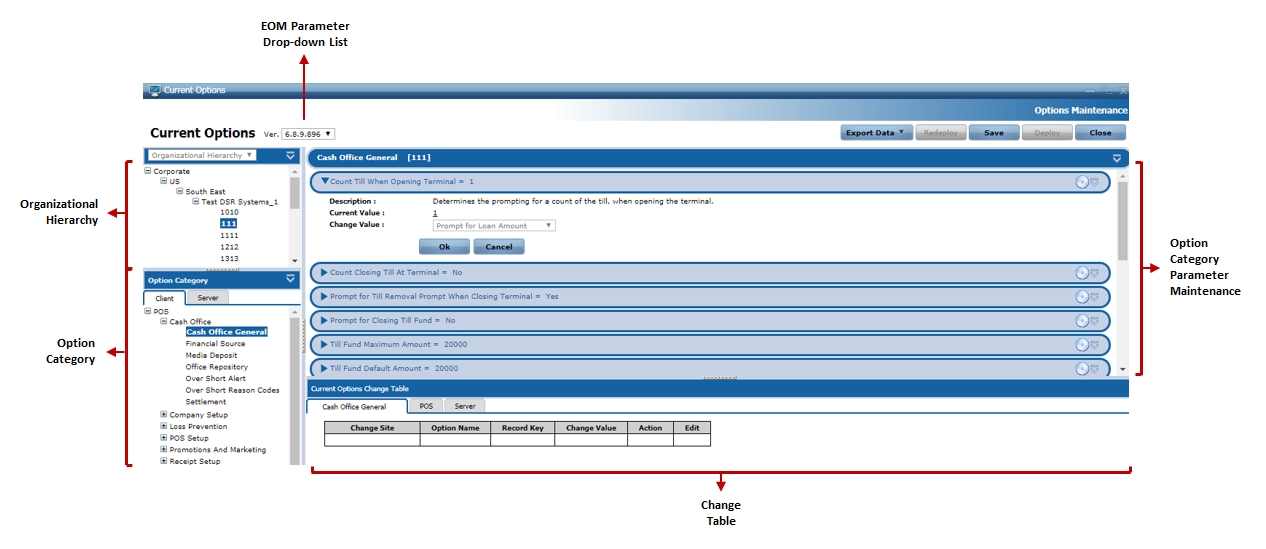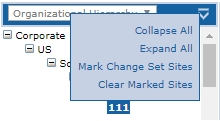Current Options window
The Current Options window displays either the current options or the change set’s options depending on where it was accessed. It can be accessed from either of the following:
- Current Options—displays the list of current options in a retailer’s Enterprise.
- Change Set Maintenance—displays the list of options for a selected change set.
The Current Options window is divided into the following panes:
- EOM Parameter Version drop-down list
- Organizational Hierarchy
- Option Category
- Option Category Parameter Maintenance
- Change Table

To access the Current Options window, follow these steps:
- From the EOM window, select EOM under the System Task list on the left portion of the window.
- Do one of the following:
- Select Current Options.
- Select Change Set Maintenance, then from the list of change sets, select a change set name.
The application displays the Current Options window.
Current Options menus
Refer to the following table for descriptions of icons that are used to manage information in the Current Options window.
| Icon | Name | Description |
|---|---|---|
|
|
Pane Menu | Displays a window that provides options to help manage and sort information. |
|
|
Default Value Indicator | Indicates that a default value is set for the parameter. |
|
|
Cancel* | Indicates that all values of an option parameter cannot be changed. |
|
|
Exclamation Point* | Indicates that at least one value of a multi-record parameter can be changed. |
|
|
Lock* | Indicates that a multi-record parameter value cannot be changed. |
|
|
Expand | Displays the option parameter details. |
|
|
Collapse | Hides the option parameter details. |
|
|
Modify | Modifies option details. |
|
|
Delete | Deletes option changes. |
|
! |
Path Indicator | Indicates the path to the nodes and change sites where change sets are deployed or are scheduled for deployment. |
|
|
Inheritance Indicator | Indicates that the parameter value is inherited from a parent node. |
Fields marked with an asterisk (*) apply to blacklisted parameters only.
The following buttons are also available in the Current Options window:
- Export Data drop-down list—exports the options into an Extensible Markup Language (XML) file, a Comma Separated Values (.csv) file, or a Microsoft Excel (.xls) file. For more information about exporting an XML file, refer to Deploying Options to Different EOM Servers.
- Redeploy—redeploys option changes or redeploys the change sets.
- Save—applies changes made to a change set.
- Deploy—deploys option changes or deploys the change set.
- Close—closes the window.
EOM parameter version drop-down list
This drop-down list displays all the EOM parameter versions that are supported by the retailer’s EOM Server. By default, only the installed parameter version is displayed in the drop-down list; any parameter version updates will be added in the drop-down list.

Select a version to display the following:
- The stores with POS terminals installed with the same version are enabled in the Organizational Hierarchy pane.
- The options corresponding to the selected version are displayed and are configurable in the Option Category Parameter Maintenance pane.
Organizational Hierarchy pane
The Organizational Hierarchy pane displays all the nodes or change sites within the Enterprise. The organizational hierarchy observes the following order:
- Corporate
- Region
- Zone
- District
- Store
The AS solution does not support moving the store taxonomies. To change the organizational structure for a store, the store must first be deleted and then re-added. EOM entity maintenance should only be done through the Enterprise Solution Web API taxonomy maintenance applications. For EOM entity maintenance, applying EOM batch files are not supported and should not be used. Failure to use the Enterprise Solution Web API taxonomy maintenance applications may result in a mismatch in the taxonomies in the EOM and Enterprise organizational structures.
For assistance in performing changes to the organizational structure on any store branches or to customize EOM’s Organizational Hierarchy, contact an NCR Professional Service (PS) representative.
To manage and sort the information in the Organizational Hierarchy pane, hover over the pane menu icon.

The application displays the following options:
- Collapse All—hides the list of all the nodes or change sites in the organization’s hierarchy tree.
- Expand All—displays the list of all the nodes or change sites in the organization’s hierarchy tree.
- Mark Change Set Sites—displays the change sites where a change set is to be deployed.
- Clear Marked Sites—cancels the change site deployment assignment.Note
Change sites (nodes) with red exclamation points (!) indicate a path to the nodes under it where a change set is deployed or is scheduled to be deployed. The nodes that are directly affected by the change set deployment are highlighted to indicate that they contain all or a portion of the option changes. If no changes are made to options in the change set, no indicator marks are displayed on the nodes.
Option Category pane
The Option Category pane displays all the option categories available for the Client and Server. The option categories contain all the parameter records that can be modified or added.
Use the Client and Server tabs to switch between Client parameter options view or the Server parameter options view.
- Client—displays all client-related parameter records that can be modified or added to a change set. Note
The Client tab contains POS as the default parameter set or Touch Type. The retailer may add, delete, or rename multiple Touch Types. For more information, refer to Adding new Touch Types.
- Server—displays all server-related parameter records that can be modified or added to a change set.
To manage and sort the information in the Option Category pane, hover on the pane menu icon to display and select any of the following options:
- Collapse All—hides the list of available POS or server parameter options.
- Expand All—displays the list of available POS or server parameter options.
- Mark Changed Options—indicates the options where parameter changes are made.
- Clear Marked Options—cancels the parameter changes made.
Option Category parameter maintenance pane
The Option Category Parameter Maintenance pane displays all the parameters of a selected option in the Option Category pane. Use this pane to add parameter records or modify parameter values.
To manage and sort the information in the Option Category Parameter Maintenance pane, hover on the Pane menu icon to display and select any of the following options:
- Add Record—adds a new parameter record to multi-record parameters.Note
The Add Record option only displays a list if the selected option parameter is a multi-record parameter.
- Collapse All—hides all the option parameter details.
- Expand All—displays all the option parameter details.
Option Category bar
The Option Category bar is a dynamic bar that is updated based on the following details:
[Option Category][Change Site]

Option panel bar
Each option in the Option Category Parameter Maintenance pane is indicated by an Option Panel bar.

Option parameter details display in the option panel bar as follows:
Option Parameter Name (Option Parameter Number) = Value
To modify option parameter values, refer to Modifying parameter values.
Each Option Panel Bar has the following indicators:
- Default Value Indicator (
 )—indicates that a default value is set for the parameter.
)—indicates that a default value is set for the parameter. - Blacklisted Parameter (
 ,
, ,
, )—displays the user role’s permission to change the values of an option parameter.
)—displays the user role’s permission to change the values of an option parameter. - Hierarchy Indicator (
 )—displays when the option is inherited from the parent node.
)—displays when the option is inherited from the parent node.
For more information about the parameter or track the change sites or nodes where the option parameter change is deployed, select the Pane Menu icon to display and select any of the following options:
- Collapse All—hides all the option parameter details.
- Expand All—displays all the option parameter details.
- Mark Change Sites—highlights the nodes in the Organizational Hierarchy pane where the parameter changes are deployed or scheduled to be deployed.
- Help—displays a Parameter Help window showing a brief description about the selected option parameter.
Change Table pane
The Change Table pane displays information about the options and parameter values that were modified.
The Change Table pane contains the following tabs:
- [Option Category] name tab—displays a summary of the options modified in the option category selected from the Option Category pane. The tab name changes according to the selected Option Category (name).
For example, selecting General from the Option Category pane displays the summary of the options that were changed in the General Option Category.

- [Client Touch Type] tab—displays a summary of the options modified under the Touch Type selected from the Option Category pane.
- Server tab—displays a summary of the server-related options that were modified.
POS is the default parameter set or Touch Type. The retailer may add, delete, or rename multiple Touch Types. For more information, refer to Adding new Touch Types.
If the previously saved change set is no longer valid based on the organizational hierarchy version or the active version of the metadata device version, additional error tabs may be displayed in the Change Table pane.
[Option Category] name tab
The [Option Category] tab is the first tab in the Change Table pane. The tab name changes according to the selected Option Category (name) in the Option Category pane. Use the following table to identify the information displayed in the [Option Category] tab.
| Header | Description |
|---|---|
| Change Site | Specifies the nodes or change sites where option changes are deployed. |
| Option Name | Indicates the name of the parameter modified. |
| Record Key | Displays the value of the key field option in order to identify the record that was modified when multi-record options were included in the change set. This column is blank if an option is not a multi-record option. |
| Change Value | Specifies the new value applied to the modified option. |
| Action | Specifies the action taken on the option. |
| Edit | Displays icons that permit options to be edited or removed from the change set:
|
[Client Touch Type] tab
Use the following table to identify the information displayed on the POS tab.
| Header | Description |
|---|---|
| Option Group | Specifies the name of the option group where the modified option belongs. |
| Change Site | Specifies the nodes or change sites where option changes are deployed. |
| Option Name | Indicates the name of the option modified. |
| Record Key | Indicates the key value if a multi-record value was added to the option. |
| Change Value | Specifies the new value applied to the modified option. |
| Action | Specifies the action taken on the option. |
| Edit | Displays icons that permit options to be edited or removed from the change set:
|
Server tab
Use the following table to identify the information displayed on the Server tab.
| Header | Description |
|---|---|
| Change Site | Specifies the nodes or change sites where option changes are deployed. |
| Option Group | Specifies the name of the option group where the modified option belongs. |
| Option Name | Indicates the name of the option modified. |
| Record Key | Indicates the key value if a multi-record value was added to the option. |
| Change Value | Specifies the new value applied to the modified option. |
| Action | Specifies the action taken on the option. |
| Edit | Displays icons that permit options to be edited or removed from the change set:
|
Additional error tabs may appear if the previously saved change set is no longer valid based on the organizational hierarchy version or the active version of the metadata device version.